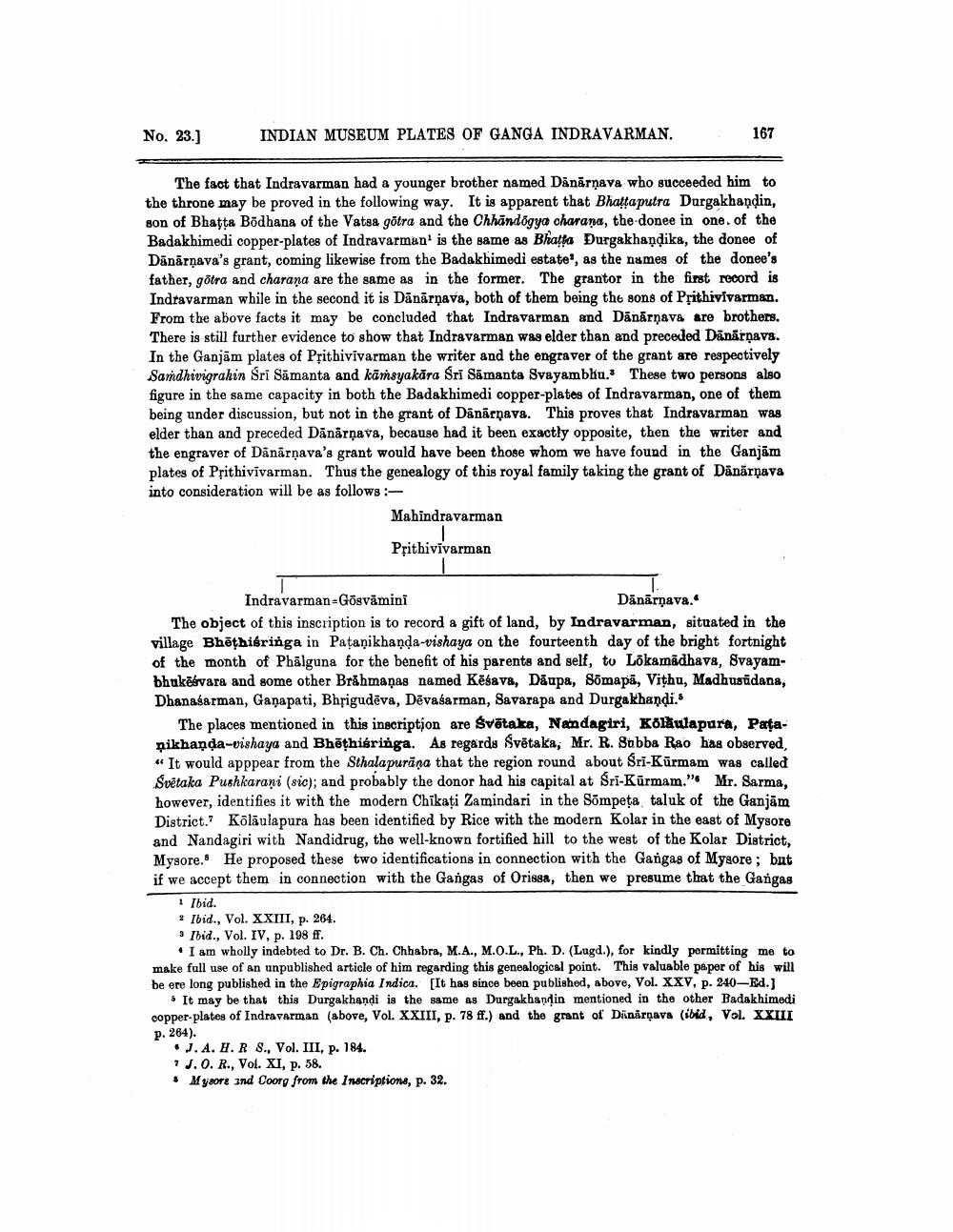________________
No. 23.]
INDIAN MUSEUM PLATES OF GANGA INDRAVARMAN.
167
The fact that Indravarman had a younger brother named Danārṇava who succeeded him to the throne may be proved in the following way. It is apparent that Bhattaputra Durgakhaṇḍin, son of Bhatta Bodhana of the Vatsa götra and the Chhandogya charana, the donee in one. of the Badakhimedi copper-plates of Indravarman1 is the same as Bhatta Durgakhandika, the donee of Danārṇava's grant, coming likewise from the Badakhimedì estate, as the names of the donee's father, götra and charana are the same as in the former. The grantor in the first record is Indravarman while in the second it is Danārṇava, both of them being the sons of Prithivivarman. From the above facts it may be concluded that Indravarman and Dānārṇava are brothers. There is still further evidence to show that Indravarman was elder than and preceded Danārṇava. In the Ganjam plates of Prithivivarman the writer and the engraver of the grant are respectively Samdhivigrahin Sri Samanta and kāṁsyakāra Śrī Samanta Svayambhu. These two persons also figure in the same capacity in both the Badakhimedi copper-plates of Indravarman, one of them being under discussion, but not in the grant of Dänärpava. This proves that Indravarman was elder than and preceded Dānārņava, because had it been exactly opposite, then the writer and the engraver of Danārṇava's grant would have been those whom we have found in the Ganjām plates of Prithivivarman. Thus the genealogy of this royal family taking the grant of Danārṇava into consideration will be as follows:
Mahindravarman Prithivivarman
Indravarman=Gösvāmini
Dānārṇava.
The object of this inscription is to record a gift of land, by Indravarman, situated in the village Bhethiéringa in Patanikhanda-vishaya on the fourteenth day of the bright fortnight of the month of Phalguna for the benefit of his parents and self, to Lōkamādhava, Svayambhukesvara and some other Brahmanas named Kesava, Daupa, Sōmapa, Viṭhu, Madhusudana, Dhanasarman, Ganapati, Bhrigudēva, Dēvasarman, Savarapa and Durgakhandi.
The places mentioned in this inscription are Svētaka, Nandagiri, Köläulapura, Pațanikhaṇḍa-vishaya and Bheṭhieringa. As regards Svētaka, Mr. R. Subba Rao has observed, "It would apppear from the Sthalapurana that the region round about Sri-Kurmam was called Svetaka Pushkarani (sic); and probably the donor had his capital at Śrī-Kurmam." Mr. Sarma, however, identifies it with the modern Chikați Zamindari in the Sompeta taluk of the Ganjam District. Kōlaulapura has been identified by Rice with the modern Kolar in the east of Mysore and Nandagiri with Nandidrug, the well-known fortified hill to the west of the Kolar District, Mysore. He proposed these two identifications in connection with the Gangas of Mysore; but if we accept them in connection with the Gangas of Orissa, then we presume that the Gangas
1 Ibid.
2 Ibid., Vol. XXIII, p. 264.
3 Ibid., Vol. IV, p. 198 ff.
I am wholly indebted to Dr. B. Ch. Chhabra, M.A., M.O.L., Ph. D. (Lugd.), for kindly permitting me to make full use of an unpublished article of him regarding this genealogical point. This valuable paper of his will be ere long published in the Epigraphia Indica. [It has since been published, above, Vol. XXV, p. 240-Ed.] It may be that this Durgakhandi is the same as Durgakhandin mentioned in the other Badakhimedi copper-plates of Indravarman (above, Vol. XXIII, p. 78 ff.) and the grant of Dinārṇava (ibid, Vol. XXIII p. 264).
J. A. H. R S., Vol. III, p. 184.
J. O. R., Vol. XI, p. 58.
Mysore and Coorg from the Inscriptions, p. 32.




